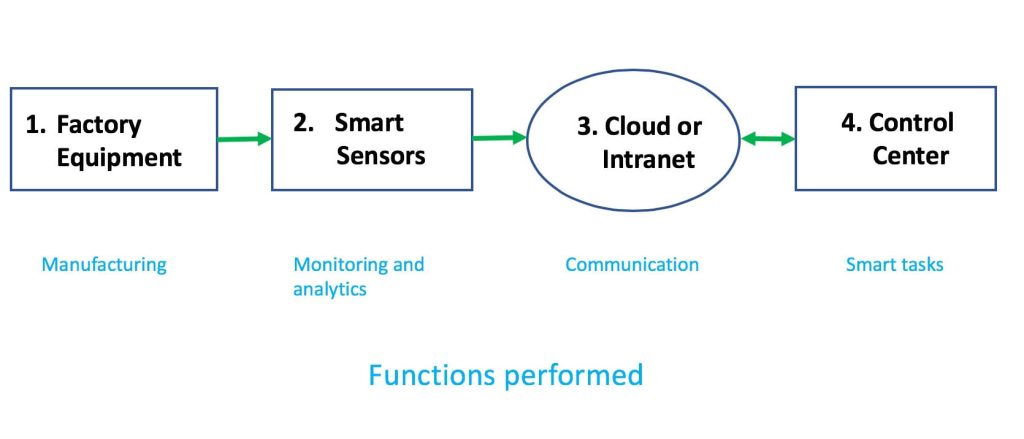How smart is your factory? Industry 4.0 and the digital transformation process will revolutionize the future of manufacturing. By making decisions based on the meaningful use of real-time data collection from various machines, the manufacturing process can be more efficient, suffer less downtime and ultimately add more profits to the bottom line. Smart sensors are the key element in making your factories smart. IoT will augment the use of sensors whose function is to convert parameters of physical science such as temperature, pressure, force, gravity, flow, etc., into electrical signals. According to BCC Research, by 2023 the sensor market will reach $283.4 billion while IoT sensors will be $48 billion.
Traditionally, machines on the shop floor require manual labor to do checkups and routine maintenance. When a machine breaks down, the maintenance crew will respond to the crisis which can be disruptive and costly. Increasingly, manufacturing equipment or machines are networked and monitored. Initially, machines are connected to multiple sensor devices which monitor the operation of the machine 24/7. Real-time data will be communicated to the control center, and the software in the control center or operations room will process the data with human operators watching the display. When something goes wrong, the display may change color and sound an alarm.
Smart sensors will take this to the next level. By relying on real-time data collection and analytics, a smart, connected factory will reap the benefits of automation and flexibility unthinkable before. Figure 1 shows an illustration of a typical design of a smart factory using smart sensors.

- New factory equipment comes with embedded smart sensors to monitor the operational parameters of that equipment. If it is motor driven, for example, the equipment will generate a certain amount of heat which is perfectly normal. A temperature profile is developed based on the specification. The smart sensors can detect the temperature, and when it exceeds the profile, it will send data to the control center. Note that temperature is only one example parameter used in this case. It can be flow control, vibration, and many others.
- Smart sensors come with built-in ASIC processors and memory, capable of measuring and performing calculations to provide useful analytics. As discussed in section 1 above, the sensors will only send warning data if it exceeds the allowed temperature. In another application, it might be a smart sensor monitoring the thermostat. The control center or server does not need to receive the reading of the thermostat every second, only when it exceeds the preprogrammed temperature. This is called “meaningful use” basis for analytics or calculations.
- Communication is key to building a smart factory. This can be done either hardwired or wirelessly using Wi-Fi or other wireless protocols. When a cloud connection is used, it will allow the data to be shared by remote sites as well as managers or operators with wireless handheld devices or mobile phones.
- The concept of the control center is changing. In the past, there was typically a process control room monitoring equipment in a factory or a chemical plant. Nowadays, the monitoring, communication, and control are all done automatically by machines. On a need-to-know basis, the manager or operator will only be disturbed if a warning signal is sent. The “control room” can be a server sitting in a computer room rack. A cell phone, in effect, is your control room. Many smart tasks can be done automatically. For example, when a factory machine temperature is gradually rising, it is an indication of a potential problem. This can be caused by many things including the gradual wearing out of ball bearings in the machine. When the temperature exceeds its pre-determined profile, the smart sensor will send a message to the “control room” which will automatically schedule the maintenance crew to do a routine check-up and repair. Rather than waiting for an actual failure before acting, this preventive maintenance can save significant costs over the year.
Unless you are building a new smart factory from the ground up, many factories are using old machines, and it can be costly to modify them by adding sensors and a new network system. But new solutions are available to solve this problem. Companies provide sensing device connecting to thermal couples allowing digital signals to be sent via a wireless hub. Soon the wireless function will be built-in. Figure 2 is a sample of a sensing device with built-in LoRaWAN, low power wireless area network. It is expected more integration will occur in the future.
The concept of Industry 4.0 will remain unchanged for a long time. The above is just one illustration of what some smart factories are doing, though different factories will require different sensors to do the monitoring. More smart sensors are expected to come to market, and wireless communication will continue to provide the needed connection to those sensors and diagnostic and other connected equipment. The application of smart sensors in manufacturing is extensive and is becoming more so every day. Some of the many monitored parameters include motion, acceleration, air quality, color, current, flow force, gyroscopes image, pressure, fluid level, photoelectric, proximity, pressure, humidity, strain, and more. We are, indeed, witnessing a revolution in smart manufacturing thanks to smart sensors.


